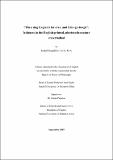| dc.description.abstract | Throughout the nineteenth century, Ireland was by far the most dominant national
trope in English-printed street balladry, appearing as specified place in English streetballadry almost as much as England itself. Ireland was imagined through melody and
performance on street corners, at fairs, in workplaces and in homes via singers and the
printed ballad-sheets that increased exponentially between the eighteenth and the
nineteenth centuries. It was a presence that made itself known in these songs either as
central character, as tonal background, as political issue, as metaphor for rurality or
resistance, or via a song’s Irish protagonists. Its image in popular English street
culture changed throughout the century as new representations emerged: beginning as
a place of imagined frivolity at the end of the eighteenth century it became a place
associated with righteous outrage at the beginning of the nineteenth; in the 1830s it
became an equal member of the union of “roses” while simultaneously the epitome of
Romantic-nationalism; and in the mid-nineteenth century it became a bucolic
backdrop in narratives of emigration while also emerging as potent symbol of political
resistance. As imagined place, Ireland became an increasingly multi-layered focus
point for a range of disparate themes and narratives that emerged layer by layer –
comic, rebellious, oppressed, idyllic, nostalgic – and that were, in turn, received,
embodied, re-created and performed within England. Ireland was presented in many
unionist songs (and often in literary culture) as England’s significant “Other”, but
readings of Irish-themed street-songs in England as a whole show that it was also
received as a significant “Other” in ways beyond the national. These representations
and receptions provide insight into various identities within England that were built
less upon the idea of nation than upon ideas such as resistance against political,
societal and cultural change, against industrialization and urbanisation, and against the
increasing regulation of economic and social life. | en_IE |


